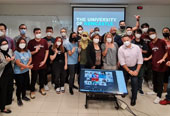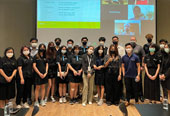Business School Deans: A Female Perspective


DATE
28/02/2020
AUTHOR
Professor Ruth Ashford, Chief Academic Advisor Nurture Higher Education Group
Introduction
The Business School could be considered as the beating heart of any successful Global University. Most Business Schools are successful in developing the next generation of effective global business leaders/entrepreneurs and have a valuable role within, not only the University, but also within communities across the world. As a Business School Executive Dean and Pro Vice Chancellor for over ten years, the author considers the leadership of successful Business Schools from a female perspective, offering some thoughts about how female Business School Deans could survive and thrive in this dynamic HE environment.
Background
Changes in HE and the Business School The Higher Education (HE) environment has been in a state of uncertainty and change over the last 10 years, with the introduction of new government policies for funding in certain countries (such as UK); challenges in developing skills for new economies and technologies; and social challenges of access, social mobility and wellbeing. The demanding student and changes in learning behavior (as a response to the technology revolution) impacts on a University’s approach to managing student experience and success. More transnational and cross-institutional approaches to higher education worldwide really has changed the traditional model of Universities. Industry and employer’s needs have changed radically, and Universities must respond and provide a wider talent pool and contribute to the enhancement of social mobility worldwide.
The Business School is often the largest Faculty within the business school, and usually offers a wide range of activities such a plethora of undergraduate and postgraduate/doctoral programmes and quality business consultancy/research worldwide. Therefore, Business School Deans are not only important strategic actors within Universities (CABS 2015), but they are often under pressure to ensure increases in student numbers (i.e. income); excellence in research income/output; ensure excellent student experience and employability; consult and research with regional, national and global industries; maintain an excellent reputation (via accreditations such as Association to Advance Collegiate Schools of Business - AACSB, Association of MBAs - AMBAs, etc); and improve global rankings.
Even in 2020, there is still a gender issue in the leadership of Business Schools as the Dean’s role is male dominated, and worldwide only 25%-30% of Business Schools have a female Dean. (although this is growing). Indeed, there is a worldwide dearth of talent at this level, with many Deans who stepped up to the role often in post as an unplanned career move (CABS, 2015).
Are Deans Managers or Leaders?
There is a wealth of literature relating to the field of leadership from different disciplines and perspectives, including general management literature (Peters and Waterman, 1982; Mintzberg, 1979) and education literature (Middlehurst, 1993 and 1999). Hesburgh, (1988), identifies an academic leader as someone who requires a clear vision, is a good communicator and is able to motivate colleagues, keeping focused and staying on course optimistically. Other authors (Middleshurst, 1993) argue that academic leaders need to be very creative and embrace innovative challenges. This sentiment is echoed by leading marketing academics (Argyriou, Leeflang, Saunders and Verhoef, 2008), who state that understanding the ‘customer’ and being creative in producing original and exciting, leading approaches for offerings is paramount to an organisation’s success. However, Rowley, (1997) argues that leadership can be influenced by factors such as a University faculty’s stage of development, the academic discipline area and its standing/size within the organisation, the senior manager’s personal style and the specific management function such as Dean, Executive Dean and Pro Vice-Chancellor. She goes on to identify that, typically, the senior academic manager’s strategic leadership requires the creation and taking forward of visions relating to future market position and reputation management, which includes the creation of culture, systems and shared values, (assuming that there is not an imposed hierarchical control of culture). Indeed, there is a school of thought that Business School Deans are ‘hybrid leaders’ i.e. leaders who can easily transcend between the professional agenda and the managerial one (Ferlie Ashburner, Fitzgerald and Pettigrew, 1996:194 and Ferlie et al 2014). The role of a Business School Dean is wonderful - but not easy by any means in this current dynamic environment.
Business School Deans: Why is there still a Gender Imbalance?
The HE sector suffers from a lack of gender diversity in relation to Business Deans. As noted above, although there has been a marked increase over the past 10 years, there are still only about 25-30% female Deans of Business Schools (CABS, 2015). This imbalance mirrors the lack of female CEOs in organisations internationally. The lack of female deans relates to the general debates around the ‘glass ceiling’ and the associated issues which impact on women in general i.e.; explicit (e.g. education – less females have had access to complete PhDs) and implicit barriers (‘old boys club’ and unconscious bias). Some ‘taboo’ areas relating to this phenomenon are now being researched and as a result more openly discussed/ in the media. The impact of the peri and post menopause for leaders (NEU, 2020, Institute of Leadership and Management), work-life balance and the impact of ‘sandwich generation’ (which females often experience i.e. caring roles for elderly parents, children and grandchildren), and general confidence issues are key concerns for the future recruitment of female Deans. Although cultures promoting gender diversity are now more fully embraced, with legislation and governmental policies in certain areas of the globe, it is likely that it will take quite a while before the imbalance is fully addressed.
What is the Recipe for Female Deans to Survice and Thrive?
This section offers suggestions, (which have been developed from insight and experience in the sector), which hopefully might stimulate some thought-provoking discussion for females (and males) to survive and thrive as a Business School Dean and act as role model within the University and sector.
1) Lead and communicate demonstrating compassion and care: the role of Dean, female or male, is about leading in a dynamic environment, and ensuring stakeholder buy-in. Deans will need to make well researched decisions and act on those decisions. Successful leaders are excellent communicators and now, with the wealth of communication channels available, Deans need to ensure that they select their messages and communication methods to demonstrate care and compassion for all stakeholders from students, to industries to faculty members, etc. The key is that stakeholders want to know that their Dean is fair and cares. This is a simple concept, but the magic is in the execution, ensuring that the Dean takes everyone with them.
2) Gain Resilience: notoriously, females tend to be ‘hard’ on themselves if things do not go as well as one would have hoped. Resilience is the key. Deans need to ensure that they can withstand adversity. Keeping positive, ensuring that the Dean look after his/her own health, trying not to burn the candle at both ends, and actually taking annual leave (rather than loosing it because they can’t find the time to take holidays) is imperative to ensure resilience. Mental health is also highly important – Deans need to ensure that they look after their mental health and find ways to gain positive feedback and give themselves rewards regularly - be it a tangible or intangible (such as simple things such as a visit to see a grandchild on the way back from work).
3) Embrace role fluidity: men and women juggle many roles in life and these roles can blend together or be quite separate. As a female, the stress of ‘managing’ elderly parents/children/grandchildren and the role of a Dean can be debilitating. Most progressive organisations will have policies/support for this and will be able to support as much as possible – however, many females do not want to seek such support for the fear of being viewed as a ‘weak’ leader. Women need to embrace their role fluidity and be not afraid to take advantage of support mechanisms offered in the workplace. Need, this allows faculty staff to see the ‘real’ Dean rather than the perceived ‘superwoman’ and this will be a positive step forward on all fronts.
4) Embracing cange and accept control issues: most Deans often feel that they have a lack of control of the external environment – but also within the University. Such acute dynamic environments in HE sector have not been experienced previously, (with government intervention, technological advancements, customer/student demands) and as such, it can be perceived that it is difficult to manage and lead effectively. However, Deans should embrace uncertainty – search for opportunities within this changing environment. Successful Deans need to accept that they can not control areas which might make them uncomfortable. Each minuet, hour, day, week, month and year will be different and that is the joy of working in the sector – making a difference and acting on things that matter. Deans need to keep a realistic perspective and relish this uncertainty, treating it as a challenge. Deans should stay positive and not ‘beat themselves up’ about getting decisions wrong in this environment but learn from these experiences and be relaxed.
5) Champion an inclusive culture: many female Deans feel a responsibility to champion an inclusive culture within their university. This approach is important and although time consuming, will be valuable for the organisation. Research confirms that some males champion other males within the organisation who are similar to themselves, so with the gender imbalance, this often means that women do not get such support. Therefore, female Deans need to ensure that they work hard to try to redress this imbalance and invest in the pipeline of new female Deans. Mentoring other new female Deans or Associate Deans is a very useful way of championing diversity and gaining rewarding feedback.
6) Work on personal professional network- peer to peer support mechanisms: female Deans need to ensure that they find time to work on and maintain their own personal professional network. This may feel indulgent, but it is essential for a Dean to feel grounded. This can be viewed as a peer to peer support mechanism which ensures that the Dean has a friendly ‘sounding board’ as well as gathering informal intelligence. This is rewarding as this informal professional network will often ‘help’ out and give important insights, ideas and resources. Indeed, there is usually a very strong bond between female Deans, wanting to support each other across the globe. This informal intelligence will often allow Deans to seek informal confirmation of potential decisions and actions taken. Often, this sort of network can be built from external or internal development programmes as well as professional bodies and formal Deans’ networks (such as those offered by AACSB and CABS).
Future Research
This article has discussed the role of the Dean from a female perspective and it has offered survival suggestions for successful or aspiring female Deans, proposing approaches for them to ultimately thrive. There is a call for more research to be undertaken in relation to the senior leader gender imbalance in Universities. Specifically, research on the impact of taboo barriers (such as the impact of the menopause for females) would be really useful to ensure that a strong pipeline is developed and recruited for the future of our Universities.
References
Argyriou, E, Leeflang, P, Saunders, J and Verhoef, P, (2008), “The Future of Marketing: Marketing’s decline: a wild exaggeration?” Chartered Institute of Marketing White Paper, CIM, Cookham, UK
CABS (Chartered Association of Business Schools), (2015), “Reflections on the Role of a Business School Dean”, CABS, London UK.
Ferlie, E., Ashburner, L., Fitzgerald, L. and Pettigrew, A.M. (1996) The New Public Management in Action. Oxford: Oxford University Press.
Ferlie, E., Currie, G., Davies, J. and Ramadan, N. (2014) ‘Business schools inside the academy: What are the prospects for interdepartmental research collaboration?’ In Pettigrew, A.M., Cornuel, E. and Hommel, U. (Eds.) The Institutional Development of Business Schools, Oxford: Oxford University Press, pp. 221–247.
Hesburgh, T M, (1988), “Academic Leadership”, New Directions for Higher Education, Vol 61 No 1 pp 5-8.
Institute of Leadership and Management (2020), Menopause and Managers, https://www.institutelm.com/resourceLibrary/menopause-and-managers.html 06/02/2020.
Middlehurst, R (1993), Leading Academics, Society for Research in Higher Education and Open University Press, Buckingham.
Middlehurst, R (1999) “New realities for leadership and governance in higher education sector?”, Tertiary Education and Management, Vol 5 pp 307-29.
Mintzberg, H (1979), The Structuring of Organisations: A Synthesis of the Research, Prentice-Hall, New Jersey.
National Education Union (NEU), (2020), Menopause Guide and Check List for Leaders, https://neu.org.uk/advice/menopause-guide-and-checklist-leaders, 06/02/2020.
Rowley, J, (1997), “Academic leaders: made or born?”, Industrial and Commercial Training, Volume 29, No 3, pp 78-84.
Peters, T J, and Waterman, R H, (1982), In Search of Excellence, Harper-Collins, London
SHARE ON





















